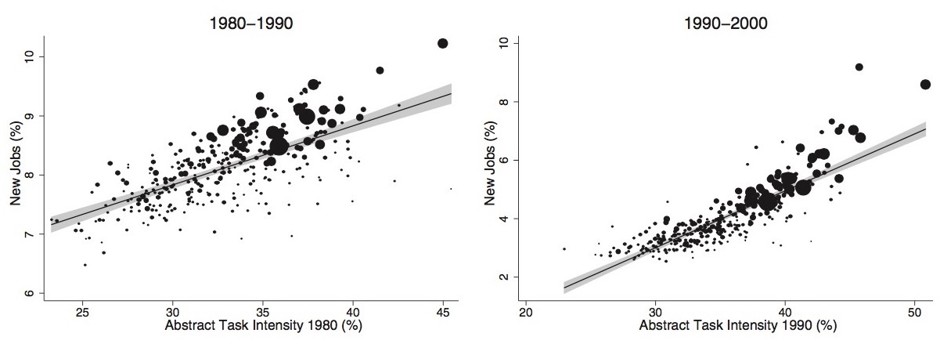How the Computer Revolution Changed US Cities
![Thin line flat desi, ... ]](https://cdn.nextgov.com/media/img/cd/2016/01/05/010516cityNG/860x394.jpg?1627540286)
Thin line flat desi, ... ] Bloomua/Shutterstock.com
After 1980, metros with an “abstract” labor base thrived, while those without one didn’t.
The rise of computer technology led to all sorts of winners and losers in the modern labor force. Some jobs (bank tellers, telephone operators, typists and the like) became easier to replace with machines; others (programmers, engineers, data analysts, etc.) became more valuable with their arrival. But it wasn’t just the fortunes of people that changed with these times—those of entire cities shifted, too, according to a new study of urban labor in the personal computer era.
The key to success, it seems, came down to whether or not residents of a given metro area possessed “abstract” skills capable of complementing computer technology, such as problem-solving, analytical reasoning, and complex communication. Metros with an abstract knowledge-base prospered, report University of Oxford researchers Thor Berger and Carl Benedikt Frey in Regional Science and Urban Economics. Those with more “routine” workforces didn’t.
“Although the computer revolution arrived everywhere, it had very different effects based on what types of work cities specialized in,” says Berger via email. “In cities with an abundance of abstract skills, the computer led to the creation of a wide variety of new work, whereas in cities specializing in routine manufacturing work it led to the displacement of middle-skill workers.”
The growth of abstract skills
Berger and Frey reached their conclusion after analyzing U.S. census labor and residential data from 1970 to 2000, alongside trends in new types of jobs and specific job tasks. They characterized these tasks as manual, routine, or abstract labor, then calculated the share of workers in a given city employed in jobs requiring these various skills. All told they included 321 U.S. cities in their study sample.
Crunching those numbers led, first, to a broad insight on changes in the U.S. labor force during this time. The researchers found a “previously undocumented shift” in the skills required for new jobs after 1980, concurrent with enormous improvements in the personal computer. During those decades, computer-related jobs became more popular, computer-related industries experienced the most job growth, and jobs that did grow fast were associated with abstract skills.

While there was “virtually no relationship” between abstract skills and new jobs before this time, a “strikingly strong relationship” emerged post-1980, the researchers report. The above table shows the occupations with the highest shares of new job titles during the 1970-2000 period. In the pre-computer years, plenty of industries based on “routine” skills make the list, including welfare aides and construction laborers.
Computer-heavy jobs that required more abstract professional skills break through in the 1980s. By the 1990s, every occupation on the list has some connection with computers. In some cases the relationship is direct (being a database administrator all but requires a computer); in others it’s more tangential (radiation therapists existed before widespread MRI technology, but that occupation burst with new jobs between 1990 and 2000).
“There is a sharp shift in new job creation around 1980—a shift that is intimately associated with the advent of the computer,” says Berger.
The success of abstract cities
The study’s second (and more novel) insight is how this shift in labor skills altered job patterns in U.S. cities. Here Berger and Frey find that, before 1980, there’s no real relationship between new job types in a city and the share of that city’s abstract workers. If anything, as the chart below shows, there’s a slightly negative link between these factors from 1970 to 1980—meaning cities with more abstract workers had slower job creation over that time.

That trend changed with the computer revolution. From 1980 on, cities filled with abstract-skilled residents capable of tackling computer-related tasks experienced steep job creation. Simply put, says Berger, the analysis found “that computer adoption was much higher in cities with an abundance of workers with abstract skills, and that in these very same cities, the more extensive adoption of computers then contributed to the creation of new work.”

The findings held up even after the researchers considered additional factors or explanations for these connections, such as city size, college-educated workers, and manufacturing declines. They also support many popular perceptions of today—the urban success of tech hubs like San Francisco, for instance, and the declines of historically industrial metros like Buffalo and Detroit.
Berger says a concentration of abstract-skilled workers generally mattered more than a concentration of abstract-based professions for a city’s success in the computer era. If that’s the case, then struggling cities might catch up by investing in their labor force—training routine workers on abstract skills, or luring the knowledge class with urban amenities. Closing the skills gap, he says, should ultimately help reduce the income inequality plaguing metropolitan America.
“Much of this divergence stems from how successful cities have been in transitioning into modern, knowledge-intensive industries,” he says. “The spread of computers contributed to growing wages at the top of the income distribution at the same time as computer-controlled equipment led to the automation of a wide range of work previously held by the middle class.”
(Image via Bloomua/Shutterstock.com)
NEXT STORY: Obama leans on tech in gun control action


